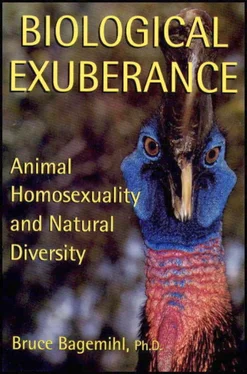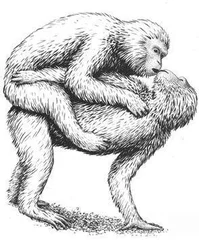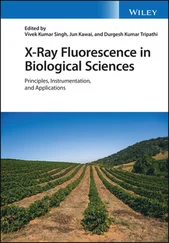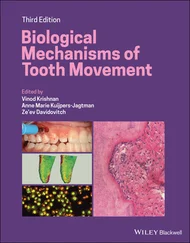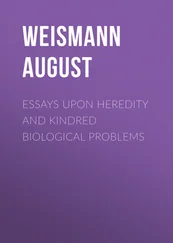Even though some of the most complete sequences of homosexual behavior in Japanese Macaques are seen in some of the most heterosexually active males, this pattern is not universal in either this species or others. In one study of Kob antelopes, for example, a female who exhibited the most fully developed sequence of lesbian courtship also participated in the second-fewest number of heterosexual matings of any of the study animals. 37And while homosexual copulations (as well as promiscuous heterosexual matings) are characteristic of heterosexually paired (breeding) males in a number of bird species (e.g., Swallows, Herons), there is not necessarily a correspondence between specific amounts of same-sex and opposite-sex activity for individual birds. In Cattle Egrets, for example, males often try to mate with birds—male or female—other than their female partner. However, one study revealed that a male who completed the most promiscuous copulations with females—and therefore was probably the most reproductively “successful”—did not engage in any homosexual copulations. Other males had homosexual encounters regardless of whether they also sought nonmonogamous heterosexual activity, indicating no necessary connection between bisexuality and breeding success. 38
Paradoxically, some of the strongest evidence against the bisexual-superiority hypothesis, as well as against genetics as the sole determinant of homosexuality, comes from the Ruff—a species in which same-sex activity between males clearly does attract females to breeding territories. To see why, we need to take a closer look at some social and biological patterns in this bird. Male Ruffs fall into four distinct classes—residents, marginals, satellites, and naked-napes—who differ from each other physically, behaviorally, and sexually. 39While it is true that females are drawn to resident males’ display territories by homosexual (and other behavioral) interactions between satellites and residents, satellites actually interfere with heterosexual mating by resident males once females have been attracted. Less than 3 percent of copulations occur when satellite males are on a resident’s territory: not only does their presence inhibit heterosexual interactions, they sometimes directly prevent residents from mating by interposing themselves between the male and the female, or by trying to knock the resident off a female’s back. 40Moreover, not all homosexual activity is associated with attracting females: same-sex mounting and courtship also occur between males who are not involved in breeding (naked-napes), between males when females are not present, and during the nonbreeding season. In addition, not all resident males participate in homosexuality: some display on their own without a satellite “partner.” If same-sex activity were vital for attracting females (and therefore breeding success) in this species, one would expect all males to engage in it. Further geographic and population differences in the occurrence of homosexual activity also argue against its being an essential component of successful reproduction.
Four classes of male Ruffs, which differ in their physical appearance, social and sexual behavior, and genetics. Clockwise from upper left: resident, marginal, naked-nape, and satellite males.
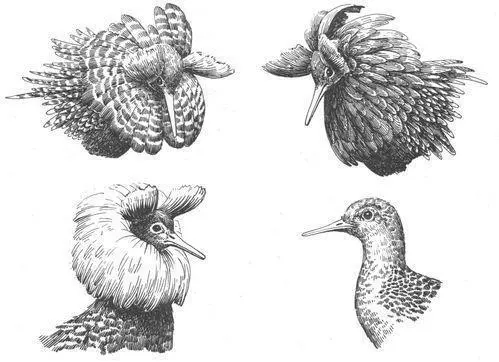
Perhaps the most important piece of evidence concerns genetic differences between the classes of males. Scientists recently discovered that the distinctions between some categories of males are genetically determined—but the genetic differences cut across differences in their homosexual behavior rather than falling in line with their sexual variations. Detailed chromosome and heredity studies revealed that whether a male becomes a resident or a satellite is genetically controlled—a finding corroborated by the fact that these two categories of males are the most physically distinct from one another in their plumage, and also by the fact that category changes between the two types are virtually impossible (satellite males never become residents or vice versa). 41Yet both residents and satellites engage in homosexual behavior—in fact, it is their joint participation in such activity that often attracts females. In stark contrast, residents and marginals are not genetically distinct: the two share many plumage characteristics, and a male may change his class membership from marginal to resident or vice versa. Yet it is precisely these two categories of males who are the most different sexually: resident males are commonly involved in both heterosexual and homosexual encounters, while marginal males are nonbreeders who rarely participate in either same-sex or opposite-sex activity.
This certainly does not mean that homosexuality lacks a genetic basis in this (or any other) species. Rather, it demonstrates the importance—the primacy, even—of nongenetic factors in the expression of homosexuality, regardless of whether it has a genetic component. A male Ruff may begin his adult life as a marginal, engaging in no sexual activity whatsoever, then change over to resident status and begin copulating with both males and females, or only females, or only males. He may even revert back to marginal status later in life, becoming asexual once again—or he may never engage in same-sex activity even as a resident or perhaps never become a resident in the first place. Other males live their entire lives as either residents or satellites, with or without homosexual activity—but in all cases, the manifestation of their sexuality is dependent on the social and behavioral contexts in which they find themselves as much as, if not more so than, on their genes. This is not to say that genetic programming or an innate predisposition for homosexuality does not exist or is unimportant—only that many other factors are involved as well.
This is in line with what else we know about the genetics of homosexuality in animals (and people). Direct evidence for a genetic component is accumulating: in several species of insects, for example, scientists have recently isolated genetic markers for homosexuality (and there are parallel findings of genetic links to homosexuality in humans). 42Yet it is also clear that social, behavioral, and individual factors are at least as important as genetic ones, especially in “higher animals” such as mammals that have complex forms of social organization and highly flexible behavioral interactions. The expression of homosexuality often varies widely between different social contexts, age groups, activities, individuals, and even populations and geographic areas, in ways that transcend any possible genetic “control.” We also saw in chapter 2 that there are good reasons to consider homosexual (and other sexual) activity to have a “cultural,” social, and/or learned dimension in a number of species, especially primates. Ultimately, then, it is of relatively little importance whether there is an actual homosexual “gene” or whether it is part of a pattern of “superior” bisexual reproduction. Even if homosexuality is shown definitively to have a genetic component (as is likely), it will always remain just that—a component, one part of a much larger picture that includes the totality of an animal’s biology and social environment.
Homosexuality in the Service of Heterosexuality
If homosexuality does not enhance reproductive performance or act as a population regulator or “helper” system, then how else might it be evolutionarily “useful”? A number of scientists have suggested some other ways that homosexual behavior could contribute, directly or indirectly, to heterosexual activity and/or breeding. In this section, we’ll look at several of these proposals, including suggestions that homosexuality is a way of practicing heterosexual mating, a method to attract opposite-sex partners, a form of competition to reduce the heterosexual mating opportunities of rivals, and several other more far-fetched “explanations.”
Читать дальше
